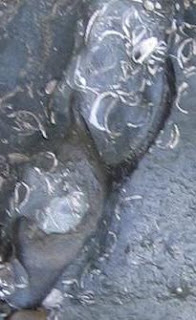In any event, there were only a few attempts to answer the quiz, and no one got it, so I'll give the answers and explanations here.
1). The whale vertebral column.
 Its difficult to see in this size, but should be more apparent when you click on the photo. One feature of this fossil indicated the anterior direction of the column - a cross section of the zygapophyses (I can't remember if these are prezygapophyses or what; perhaps I should read up on Emily Buchholtz' work). In mysticetes (and odontocetes for that matter, but they're much different in shape) these diverge anteriorly, and occur in the posterior thoracics and lumbar series. I've included a photo of a mounted Blue whale (Balaenoptera musculus) to illustrate the point. So, in the original post anterior is to the top of the photo, and here, to the left hand side. Unfortunately, this also means that if a skull is there, it is covered by about 20 feet of rock and concrete, underneath a road.
Its difficult to see in this size, but should be more apparent when you click on the photo. One feature of this fossil indicated the anterior direction of the column - a cross section of the zygapophyses (I can't remember if these are prezygapophyses or what; perhaps I should read up on Emily Buchholtz' work). In mysticetes (and odontocetes for that matter, but they're much different in shape) these diverge anteriorly, and occur in the posterior thoracics and lumbar series. I've included a photo of a mounted Blue whale (Balaenoptera musculus) to illustrate the point. So, in the original post anterior is to the top of the photo, and here, to the left hand side. Unfortunately, this also means that if a skull is there, it is covered by about 20 feet of rock and concrete, underneath a road.Note: The B. musculus skeleton is shown in lateral view, and the fossil is shown in dorsal view.
2). The unidentified bone.
 It's a mysticete scapula. The long hooklike part is the acromion process, and the wide/thick part is the glenoid fossa. So we're looking at the distal end where the humerus articulates. Here's a complete scapula for comparison: http://farm3.static.flickr.com/2398/2342861085_66b7f89293.jpg?v=0
It's a mysticete scapula. The long hooklike part is the acromion process, and the wide/thick part is the glenoid fossa. So we're looking at the distal end where the humerus articulates. Here's a complete scapula for comparison: http://farm3.static.flickr.com/2398/2342861085_66b7f89293.jpg?v=03). Another mystery 'thing'.

The mystery thing was, another mysticete fossil (see a common theme here?). In this case, this specimen is identifiable to the genus level, even though its still in the field. A) - reconstruction of the skull of Herpetocetus bramblei; B) - Pleasure Point specimen of Herpetocetus bramblei; C) - in-situ skull of Herpetocetus sp. (late Pliocene).
Unfortunately, this skull is in one of the hardest primary sedimentary rocks I've ever seen or hammered upon, and in a block the size of a refridgerator. There's no way this thing is coming out without access to a jackhammer and a truck. There are four labeled features that help identify it as Herpetocetus. Some of these are not unique to Herpetocetus, but do not occur in any other known contemporaneous mysticetes, so can be used for purposes of identification. 1) The cranial vertex; the vertex is pyramidal in shape, bears a distinct saggital crest on the supraoccipital, which is also very acute. 2) There is a distinct deep fossa medial of the dorsal crest of the squamosal, which is an synapomorphy of the clade Herpetocetinae. 3) The zygomatic process of the squamosal is anteriorly oriented. 4) The postorbital process is elongate and finger like, which may be a reversal to the primitive condition of mysticetes.
Anyway, these are just some things you can keep an eye out for in the field to help you identify in-situ fossils. As a rule, I generally collect everything that isn't a cetacean rib or vertebra.
Bobby

I feel edified. Can we cover the cetacean jaw adductor system next?
ReplyDeleteHey Neil,
ReplyDeleteThats something I definitely need to read more about before I try writing anything. But, don't worry, I'll be covering whale jaws in the future.
Oh yeah, as long as I'm making ridiculous requests--I'm not sure what you're after on your trip to the Pac NW, but some more Kolponomos material would be great. Thanks. :)
ReplyDeleteAlso if you're in the market for a field assistant....